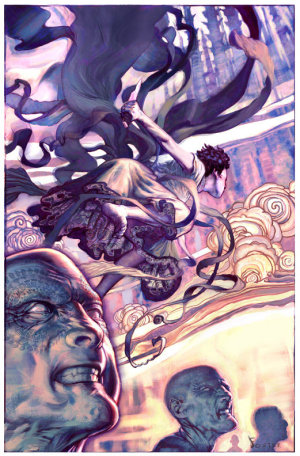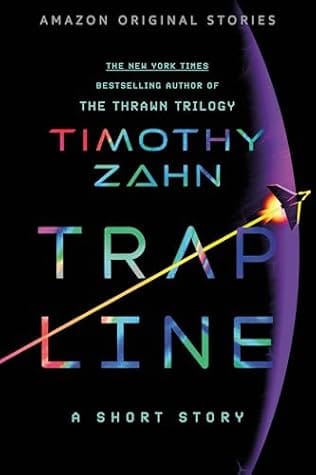Mistborn Book Review

MistbornMistborn: The Final Empire
by Brandon Sanderson
Tor Fantasy 2007
$7.99; 658 pages
ISBN 978-0-7653-5038-1
Sometimes, I worry that I'm not the hero everyone thinks I am.
The philosophers assure me that this is the time, that the signs have been met. But I still wonder if they have the wrong man. So many people depend on me. They say I will hold the future of the entire world on my arms.
What would they think if they knew that their champion—the Hero of the Ages, their savior—doubted himself? Perhaps they wouldn't be shocked at all. In a way, this is what worries me most. Maybe, in their hearts, they wonder—just as I do.
When they see me, do they see a liar?
The Final Empire is not a happy place. The teeming masses of the Empire, known as skaa, are used to clear the brown fields of the ash that falls from the sky without cease. Their unending toil brings only meager sustenance from the scorched and blighted land. When their labor is done, night falls, and the mists come. Each and every night, the world is wrapped anew in terror and mystery. Even the stout-hearted quail before the creeping tendrils. Few willingly venture outside after dark.
The life of the skaa is nasty, brutish, and hopefully short. Skaa labor provides what few luxuries the land can provide to the hereditary aristocracy. Despite their relative paucity, the aristocracy find their entertainment inadequate. Bloodsport and sexual exploitation fill the gap.
The nobility are themselves watched by the obligators, the omnipresent Imperial bureaucrats who must witness all agreements, financial or otherwise, between the nobility. The obligators are in turn watched by the terrifying Steel Inquisitors, creatures of flesh and metal who report directly to the Lord Ruler himself. None dare resist their power. One thousand years after the Hero of Ages traveled to the Well of Ascension to save the world, all is not well. Society shambles on, but it is dead, feigning the symptoms of life.
It is the time of the final cultural forms, of petrified urban-dominated society (the part of the cycle to which Spengler gave the name “Civilization” as a technical term). There is no theme to the events in the Winter: there is a lot of art and politics, but it is powerdriven, market-driven, fashion-driven. All these events simply toy with traditions and motifs which the culture created when it was alive. Usually something ghastly happens to civilizations which reach this fossil state, but according to Spengler, this something comes from outside.
-The Perennial Apocalypse, John J. Reilly
A friend recommended this book to me as something similar to Patrick Rothfuss' The Name of the Wind. I had been waiting for a copy to show up at my local used bookstore, and I finally found one just before Thanksgiving.
That is an apt comparison, the books have somewhat similar magic systems, were published about the same time, and they were both a blast to read. Other than that, these books are completely different.
This is a good thing. I really enjoy seeing similar ideas worked out in very different ways, by authors with entirely different styles. The Name of the Wind and it's sequels have a laser like focus on Kvothe; which is appropriate, since these books are the story of his life. Other characters appear, but they are always secondary to Kvothe. This fits, since Kvothe is a narcissist. Everyone else really is secondary. Sanderson, on the other hand, has an ensemble cast who all are fully part of the story, with their own plausible motivations and desires. They are not simply part of the scenery, but rather provide a richness of detail that makes the story seem more real. Sanderson also does a really good job with politics and applied psychology in this book. Deceit, manipulation, and Machiavellian politics are a major part of the story, and I loved it all.
Actually, there is one other way these books are alike; they are both about the end of the world. I know, there he goes again.
Mistborn is the tale of the brave and doomed skaa resistance to the reign of the Lord Ruler. Following the introductory apocalypse at the Well of Ascension, the Lord Ruler consolidated his dominion over the entire world. This really is the end of history, for in the Final Empire, nothing every changes, including the immortal Emperor. The Lord Ruler's grasp may grow somewhat weaker as you travel further away from his capital, Luthadel, but there are none who do not acknowledge his sovereignty.
In typical usage, a millennium is a thousand year period of peace and prosperity after the constraints of the human experience, such as war, death, and poverty, have been overcome. Sanderson has turned the concept on its head, positing a millennium where the forces of evil have triumphed instead. The Three Horsemen run rampant in the Final Empire [only War has been vanquished; War against the Emperor is inconceivable]. This kind of millennium poses as the end of history, but it is really a pregnant pause.
A millennium of this kind implies a nameless war to follow, a revolution after the revolution. The Final Empire reaps this in plenitude. In the book of Revelation, the thousand year reign of Christ comes to an end when Satan, who has been bound, but not destroyed, rises again. He will be defeated in a nameless war after the end of the world, after which the cosmos will be consumed.
Sanderson fulfills the archetype completely; the paradigm will out, even when you start out to subvert the idea. What Sanderson does maintain, the reason why I enjoyed the book so much, is the identity of good and evil. Good still wins out in the end. What remains the same is that the cosmos is consumed in the resulting conflagration. Only now, a new cosmos needs to be constructed to replace the old. This is the task the protagonists find they have created for themselves. It should prove to be most interesting.
I enjoyed this book so much that I am eagerly awaiting my next trip to the bookstore to buy the rest of the books in the series. If you have a hankering for more, you are in luck. The other two books in this trilogy are already written, and Sanderson has even greater plans for extending his ideas into a grand overarching story with more than thirty volumes. This is a venerable conceit. Writing stories that fit into the same universe is a mental savings, and fun for your fans as well. I look forward to exploring Sanderson's creations.

Comments ()